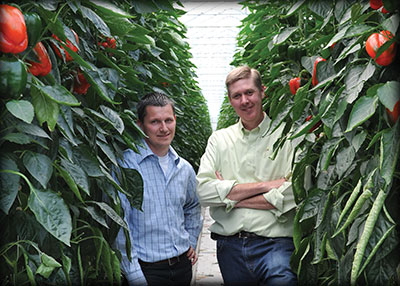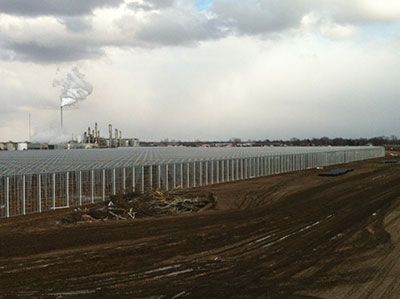
When Truly Green Farms plants its first tomato crop in July, the company
will turn the page on a new energy efficient model for greenhouse
growing in North America.
When Truly Green Farms plants its first tomato crop in July, the company will turn the page on a new energy efficient model for greenhouse growing in North America.
 |
|
| Hilco Tamminga and Greg Devries in a Cedarline Greenhouses facility. Advertisement
|
Founders Greg Devries and Hilco Tamminga got the idea to warm their greenhouses with waste heat from a local ethanol plant after a chance meeting at a farm show in 2010.
That chance encounter led to a meeting with Rick LeHoux, director of projects at GreenField Ethanol.
Devries and Tamminga weren’t the first growers to approach GreenField with a proposal to harness heat from the company’s Chatham, Ont., facility, but they were among the most persistent.
After their initial discussions with LeHoux, the pair enlisted help, hiring a Dutch firm to compile a five-year, hour-by-hour history of the weather in Chatham-Kent. They used that information to calculate their proposed greenhouse’s average hourly thermal requirements.
Armed with their data and detailed analyses, Tamminga and Devries went back to GreenField and presented the evidence of their energy needs.
“Their industry is different. Normally they turn their equipment on and then they run 24/7, so it’s a very constant energy demand,” says Tamminga. “For us, though, the energy need is more volatile. On a cold winter day we may have 100 per cent load during the night but as the sun’s radiation comes through with the morning sun, our boilers could be off by mid-morning.”
Tamminga and Devries also began examining ways of incorporating GreenField’s waste CO2 into their greenhouse project.
The end result is Truly Green Farms: a planned 90-acre greenhouse operation that will harness the byproducts of GreenField’s ethanol production and transform them into valuable inputs for growing plants year round.
WASTE NOTE, WANT NOT
Ethanol is produced by fermenting corn and converting the grain’s sugars into energy. Fermentation produces carbon dioxide and ethanol, which is distilled to boil off the water. The ethanol is then dehydrated to remove additional water, leaving 99 per cent pure alcohol ethanol.
The process also leaves the ethanol producer with leftover distillers’ grains. These consist of the protein, fat, fibre, minerals and vitamins that remain after the corn’s sugars have been converted into ethanol. These distillers’ grains can be used as a livestock feed ingredient and are dried to varying moisture levels prior to sale.
“About a third of the corn that goes into the production of ethanol comes out as CO2, a third comes out as alcohol, and about a third comes out as distillers’ grains,” says Tamminga.
“Those distillers’ grains are soaking, soaking wet and they have to be dried. That process is, in essence, where we’re getting our energy from.”
The distillers’ grains are fed into large heated dryers in order to achieve the desired moisture levels. The combination of water and heat produces steam that is drawn up a large stack and released into the air.
“We’re going to condense that vapour and collect the condensate and that water,” says Tamminga. “It will be run through a heat exchanger allowing GreenField and Truly Green to maintain closed loops and run independently because the condensate water will be acidic. We truthfully don’t want that in the greenhouse. Once it has gone through the heat exchanger, it will be pumped underneath the road to our Truly Green greenhouse.”
From there, it will be put through a header and distributed through the greenhouse as needed.
GROWING IN A NEW DIRECTION
One thing that made Truly Green’s proposal stand out from the others was its focus on the approximately 65 C water produced by the dryers GreenField uses for its distillers’ grains; many of the other projects pitched to GreenField sought to make use of the approximately 42 C water generated by the company’s cooling tower.
 |
|
| First phase construction
|
Truly Green will have some flexibility in how the hotter water is used in its greenhouses, allowing its operations to adapt in order to reap the greatest benefit.
“We did an extra distribution/transfer line in the boiler room which allows us to put a different water source through the grow pipe than we do through the tube rails,” explains Tamminga.
“If it’s January and it’s blowing like crazy, what we can then do is use the GreenField source of hot water and run that through the grow pipe and have the flexibility to top up the 65 C water to our desired temperature and put that in the tube rails. This is possible because we have incorporated extra piping.”
The key to making Truly Green viable is to have redundancy built into the system, allowing both companies to run completely independently from one another.
Energy and CO2 from GreenField are important components of Truly Green’s business model, but backups have been built into the design.
If GreenField were to experience a temporary shutdown for maintenance or even close its doors one day, Truly Green would be able to continue its operations independently thanks to backup boilers and a sufficient supply of natural gas to maintain all 90 acres of the finished pro-ject at optimal temperatures.
These backups aren’t just critical to the long-term viability of the business. They’re critical to securing the support of lenders.
Those lenders have been an integral part of turning an idea into a viable business.
In 2010, the Canadian Agricultural Adaptation Program awarded Truly Green Farms $100,000 to spearhead research to determine the feasibility of the project. And last December, the province invested an additional $3.2 million in Truly Green Farms.
“We are very thankful that the provincial government sees the value in our project and that they trusted us with their money as an investment for the province,” says Tamminga.
Phase one of four, which broke ground on the day of the funding announcement, consists of 22.5 acres of growing space. This phase will include one energy curtain, but Tamminga and Devries will be keeping a careful eye on how their tomato plants perform.
As subsequent phases of the project move forward (phase two is targeted for construction in 2015 but could get underway as early as the fall of 2014), they will determine if a second energy curtain is required.
“For the future phases, a second screen will be considered. This will allow us to stretch the 65 C as far as we can without needing the boiler supplemental top-up,” says Tamminga. “It is going to be essential that we try to limit our thermal demand to 65 C or lower. This will maximize our efficiency using the GreenField stream of energy.”
All together, teaming up with GreenField Ethanol is projected to give Truly Green’s tomato production a five per cent bump utilizing the C02 while cutting heating costs by as much as 40 per cent.
Although the company has not yet been accredited, Tamminga says Truly Green intends to pursue carbon negative certification – a move that would open the door to new marketing opportunities for its tomatoes.
Brandi Cowen is editor of Energy Edge.
Print this page